初中英语新目标(Go for it)版八年级上Unit 1 How often do you exercise? 教案
文档属性
| 名称 | 初中英语新目标(Go for it)版八年级上Unit 1 How often do you exercise? 教案 | 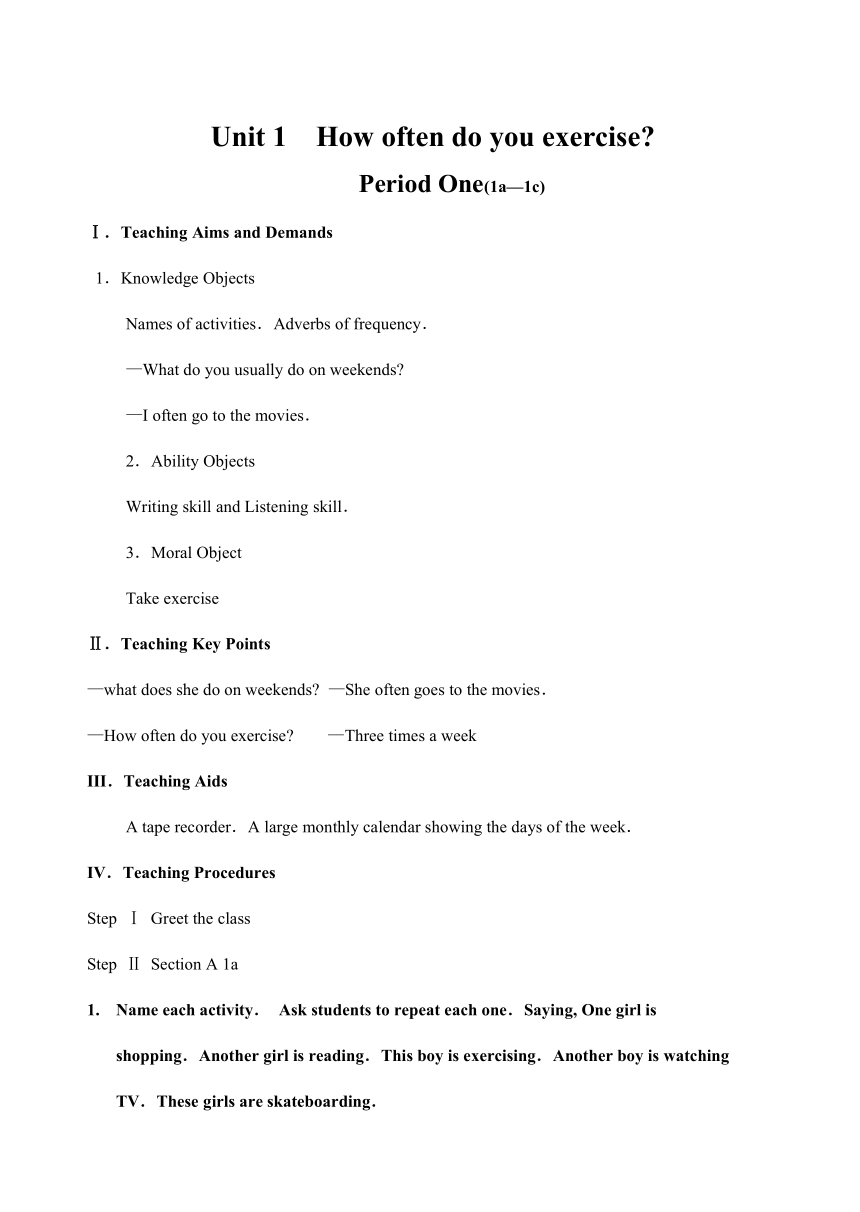 | |
| 格式 | zip | ||
| 文件大小 | 16.7KB | ||
| 资源类型 | 教案 | ||
| 版本资源 | 人教新目标(Go for it)版 | ||
| 科目 | 英语 | ||
| 更新时间 | 2011-10-02 22:32:04 | ||
图片预览

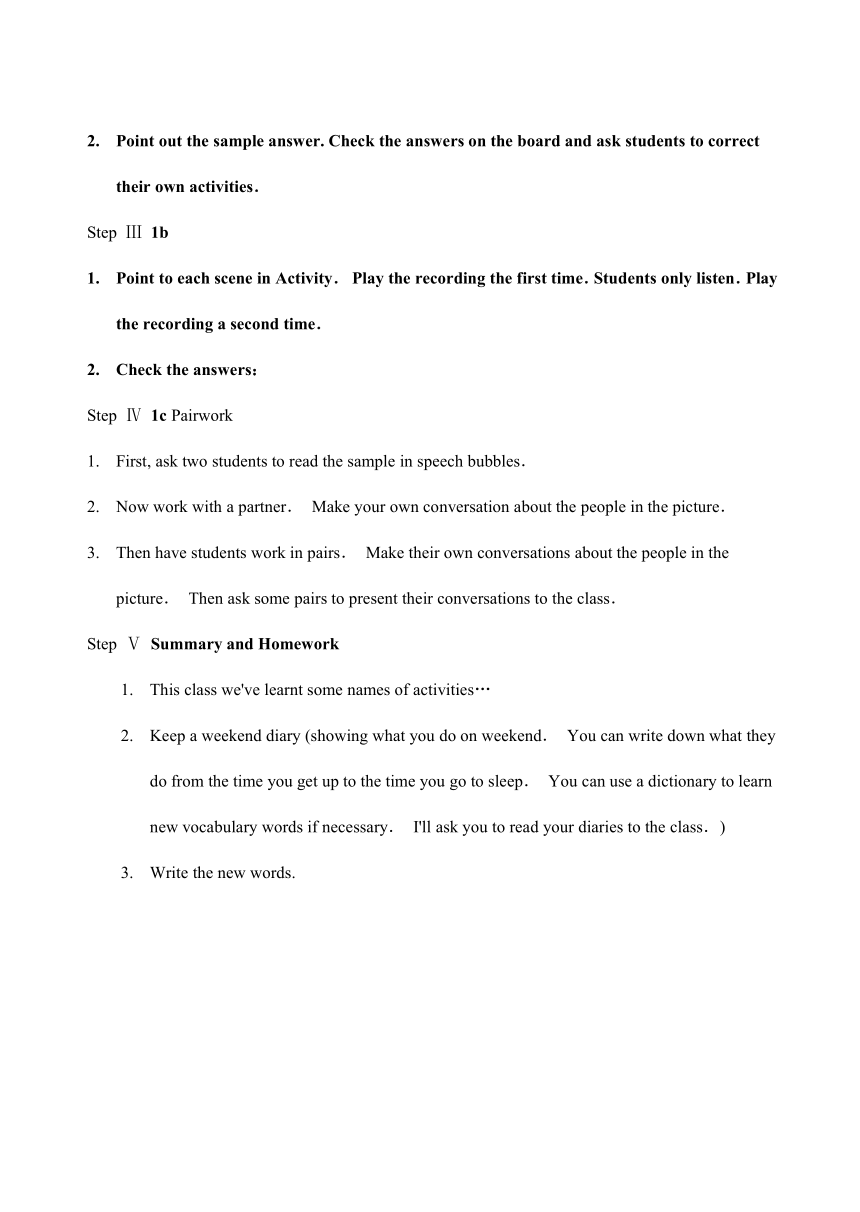
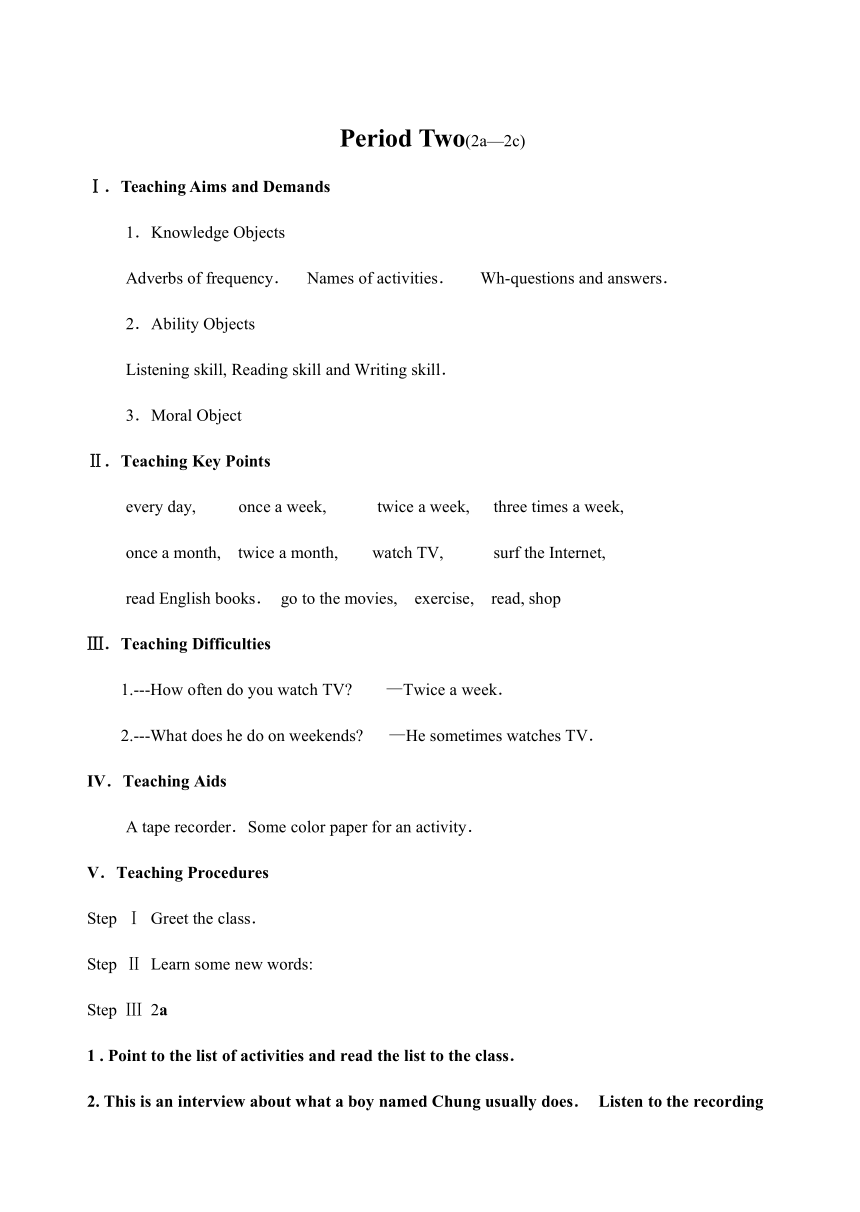
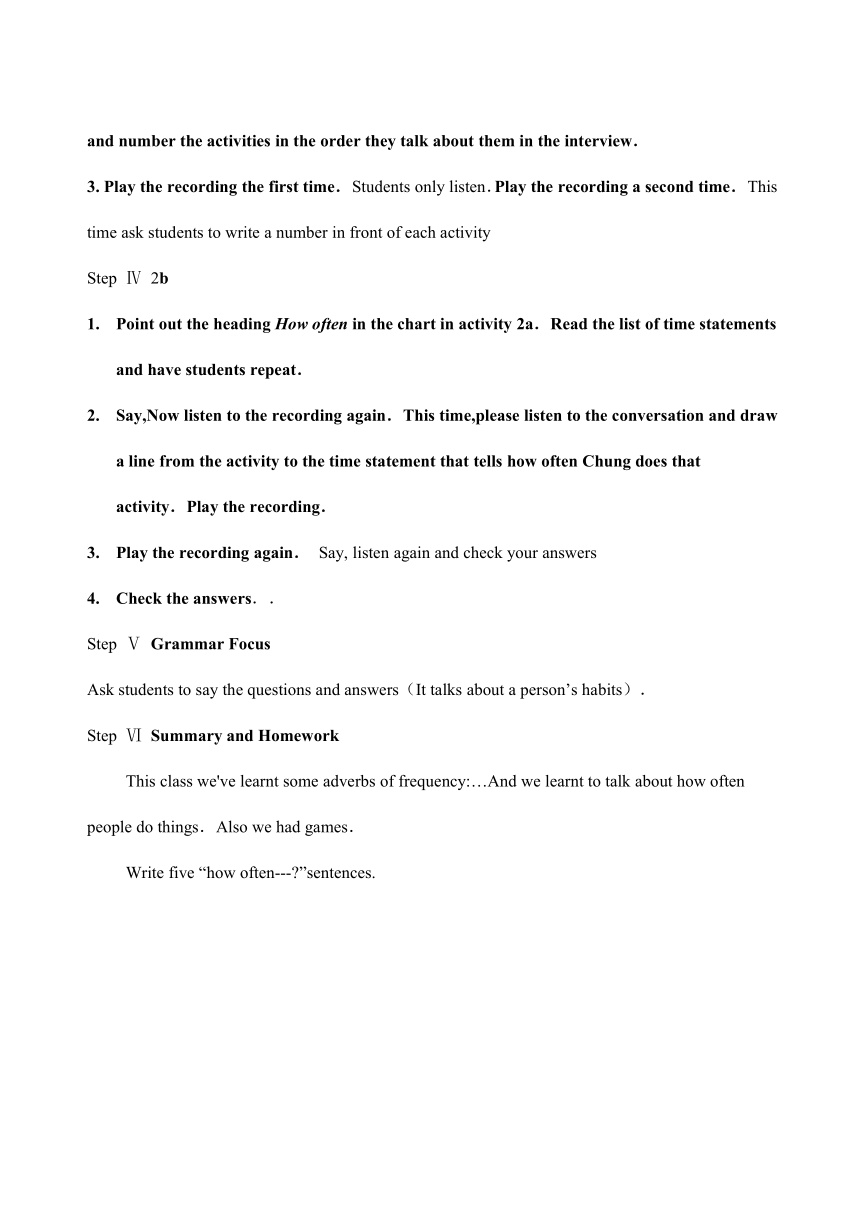
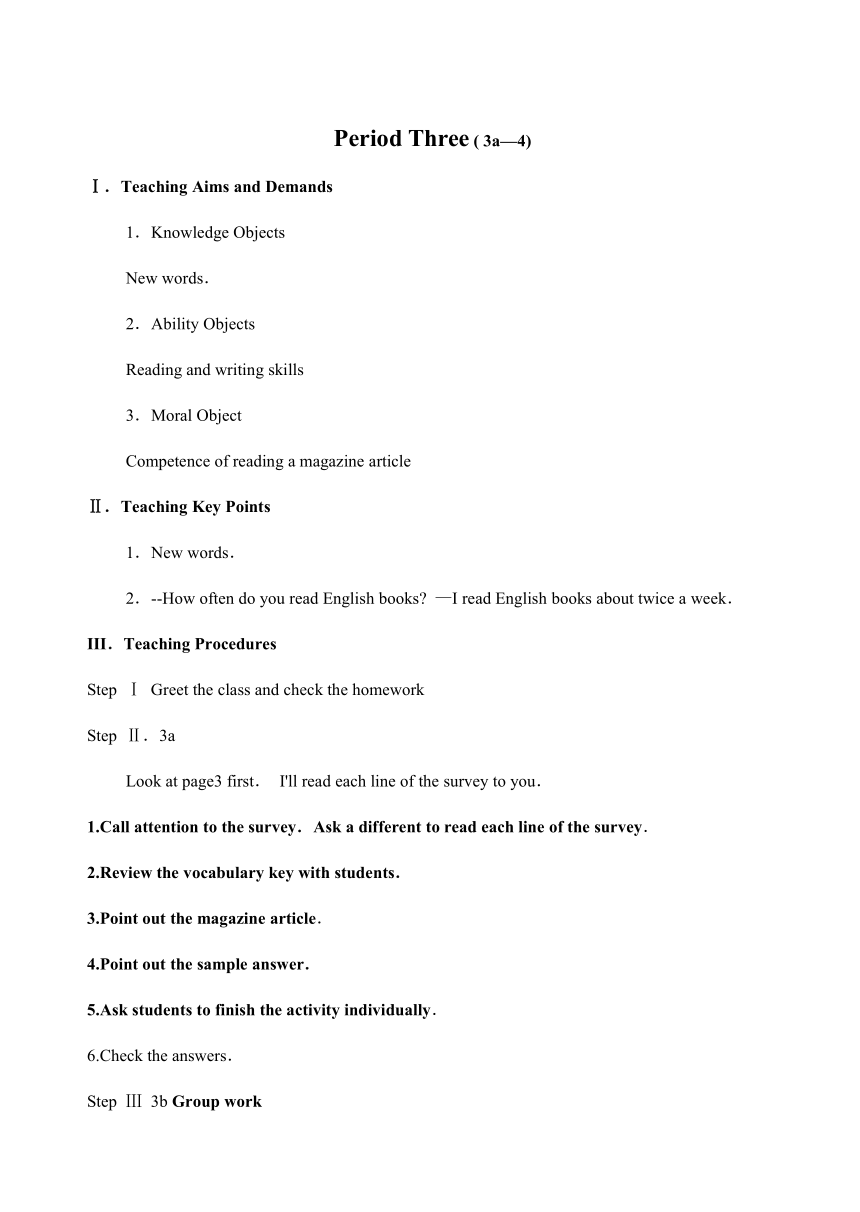
文档简介
Unit 1 How often do you exercise
Period One(1a—1c)
Ⅰ.Teaching Aims and Demands
1.Knowledge Objects
Names of activities.Adverbs of frequency.
—What do you usually do on weekends
—I often go to the movies.
2.Ability Objects
Writing skill and Listening skill.
3.Moral Object
Take exercise
Ⅱ.Teaching Key Points
—what does she do on weekends —She often goes to the movies.
—How often do you exercise —Three times a week
III.Teaching Aids
A tape recorder.A large monthly calendar showing the days of the week.
IV.Teaching Procedures
Step Ⅰ Greet the class
Step Ⅱ Section A 1a
Name each activity. Ask students to repeat each one.Saying, One girl is shopping.Another girl is reading.This boy is exercising.Another boy is watching TV.These girls are skateboarding.
Point out the sample answer. Check the answers on the board and ask students to correct their own activities.
Step Ⅲ 1b
Point to each scene in Activity. Play the recording the first time.Students only listen.Play the recording a second time.
Check the answers:
Step Ⅳ 1c Pairwork
First, ask two students to read the sample in speech bubbles.
Now work with a partner. Make your own conversation about the people in the picture.
Then have students work in pairs. Make their own conversations about the people in the picture. Then ask some pairs to present their conversations to the class.
Step Ⅴ Summary and Homework
This class we've learnt some names of activities…
Keep a weekend diary (showing what you do on weekend. You can write down what they do from the time you get up to the time you go to sleep. You can use a dictionary to learn new vocabulary words if necessary. I'll ask you to read your diaries to the class.)
Write the new words.
Period Two(2a—2c)
Ⅰ.Teaching Aims and Demands
1.Knowledge Objects
Adverbs of frequency. Names of activities. Wh-questions and answers.
2.Ability Objects
Listening skill, Reading skill and Writing skill.
3.Moral Object
Ⅱ.Teaching Key Points
every day, once a week, twice a week, three times a week,
once a month, twice a month, watch TV, surf the Internet,
read English books. go to the movies, exercise, read, shop
Ⅲ.Teaching Difficulties
1.---How often do you watch TV —Twice a week.
2.---What does he do on weekends —He sometimes watches TV.
IV.Teaching Aids
A tape recorder.Some color paper for an activity.
V.Teaching Procedures
Step Ⅰ Greet the class.
Step Ⅱ Learn some new words:
Step Ⅲ 2a
1 . Point to the list of activities and read the list to the class.
2. This is an interview about what a boy named Chung usually does. Listen to the recording and number the activities in the order they talk about them in the interview.
3. Play the recording the first time. Students only listen.Play the recording a second time. This time ask students to write a number in front of each activity
Step Ⅳ 2b
Point out the heading How often in the chart in activity 2a.Read the list of time statements and have students repeat.
Say,Now listen to the recording again.This time,please listen to the conversation and draw a line from the activity to the time statement that tells how often Chung does that activity.Play the recording.
Play the recording again. Say, listen again and check your answers
Check the answers..
Step Ⅴ Grammar Focus
Ask students to say the questions and answers(It talks about a person’s habits).
Step Ⅵ Summary and Homework
This class we've learnt some adverbs of frequency:…And we learnt to talk about how often people do things.Also we had games.
Write five “how often--- ”sentences.
Period Three ( 3a—4)
Ⅰ.Teaching Aims and Demands
1.Knowledge Objects
New words.
2.Ability Objects
Reading and writing skills
3.Moral Object
Competence of reading a magazine article
Ⅱ.Teaching Key Points
1.New words.
2.--How often do you read English books —I read English books about twice a week.
III.Teaching Procedures
Step Ⅰ Greet the class and check the homework
Step Ⅱ.3a
Look at page3 first. I'll read each line of the survey to you.
1.Call attention to the survey.Ask a different to read each line of the survey.
2.Review the vocabulary key with students.
3.Point out the magazine article.
4.Point out the sample answer.
5.Ask students to finish the activity individually.
6.Check the answers.
Step Ⅲ 3b Group work
1.Ask students what they can do to improve their English.Elicit a few examples and write them on the board.Ask a few students, how often do you(the things on the board)
2.Point out the the left hand column of the table.Say, Think of more things you can do to improve your English and write them here.As students work, move around the room offering language support.
3.Draw the table with the given examples on the board.
4.Ask a few students who they think is the best English student in the class.
Step Ⅳ Ativity
Ask students to talk about how often their family members do things. For example, My mother cooks dinner every day.We eat in a restaurant once a week.My father goes to the United States once a year.As students give examples, ask other students about the same topic.Kim; s mother cooks dinner every day.Does your mother cook dinner every day
Step ⅤSummary and Homework
This class we've read a magazine article and done an exercise.
Answer the questions.Use the words in parentheses.
Period Four(Section B 1a—2c)
Ⅰ.Teaching Aims and Demands
1.Knowledge objects
New words.
Ask and answer questions.
2.Ability objects
Listening skill.
3.Moral Object
Reading skill.Writing skill.
Ⅱ.Teaching Key Words
junk food, milk, fruit, vegetables, sleep, interviewer, healthy
Ⅲ.Teaching Difficulties
---How often do you exercise —I exercise every day.
---How many hours do you sleep every night —Nine.
IV.Teaching Procedures
Step Ⅰ Greet the class and check the homework.
Step Ⅱ Show the new words on the screen and teach the new words. Ask students to repeat them. And make sure everyone knows the meanings.
Step Ⅲ Section B 1a
1.Now open your books at page 4. Look at 1a. First I'll read each word.Please read after me.
junk food milk fruit vegetables sleep
2.Point out the five words Say each word and ask students to report it.
3.Call attention to picture c.Say something about it. For example, There are vegetables on the plate.Most people eat vegetables every day.Do the same thing for the other four pictures.
4.Then point out the blank line in front of each word.Ask students to match each word with a picture by writing the letter of the picture on the line in front of the correct word.
5.Check the answers. 1.b 2.a 3.d 4.c 5.e
Step Ⅳ 1b Pairwork
Now look at Activity 1b. I'll ask two students to read the dialogue to the class.
Now work with your partner. Please make your own conversations about the words in Activity 1a.Then I will ask some pairs to present some questions and answers to the class.
Step Ⅴ 2a
Now listen to the recording and decide if Bill and Katrina are healthy. Circle Yes, No or I don't know in the chart.
Play the recording ask students to circle Yes, No, or I don't know.
Check the answers.1.No. 2.Yes.
Step Ⅶ
Now please look at the sample answer under Katrina's name in number 1. The answer is every day because Katrina said she exercises every day.
Step Ⅶ Summary and Homework
This class we've learnt some words and learnt to interview somebody with the sentence, how often … After class please give more practice. You can interview your friends and your parents.
Period Five(3a—4)
Ⅰ.Teaching Aims and Demands
1.Knowledge Objects
New words. Read a letter from Katrina.
2.Ability Objects
Reading skill.Writing skill.Survey skill.
3.Moral Object
Fill in the blanks in Paul's letter.Write about your own habits.
Ⅱ.Teaching Key Points
eating habit, of course, look after ,make a difference, healthy, unhealthy, although
Read a letter. Fill in a letter.
Ⅲ.Teaching Difficulties
Write something about one's own habit.
Survey Who is the healthiest
IV.Teaching Procedures
Step Ⅰ Greet the class and check the homework.
Step Ⅱ Show the new words on the screen and teach them. Read the new words to students and ask them to repeat.
Step Ⅲ 3a
Open your books at page 5. Look at Activity 3a. This is the part of Katrina's letter to a pen pal. I'll read it to you first.
After reading the letter, write answers to the questions in your exercise book.
Then check the answers:
Step Ⅳ 3b
This is Bill's letter. I'll read the letter to you. (say blank each time when coming to a blank line)
… and I think I'm kind of unhealthy. I hardly ever(1) exercise. I eat ________(2) twice a week, but I never eat ________(3) . And I ________(4) to drink ________(5) . Yuck! I love ________ ________(6) and eat it ________ ________ ________ ________ (7) a week. So maybe I'm not very healthy, although I do have one healthy habit. I ________(8) for ________ ________(9) every night.
Then check the answers:
(2) vegetables (3) fruit ( 4) don't like (5) milk (6) junk food
(7) three or four times (8) sleep (9) nine hours
Step Ⅴ 3c Writing
Now write about yourself. What healthy things do you do How often do you do them What unhealthy things do you do How often do you do these unhealthy things
Step Ⅵ 4 Survey Who is the healthiest
This activity gives students listening, speaking, reading and writing practice using the target language.
Step Ⅶ Summary and homework
This class we've read two letters. We know what healthy things are and unhealthy things are. And we've learnt to write something about one's own.
Period Six(self-check)
Ⅰ.Teaching Aims and Demands
1.Knowledge Objects
Vocabulary in this unit.
Writing practice. Just for Fun.
2.Ability Objects
Reading skill.Writing skill.
3.Moral Object
Drawing skill.
Ⅱ.Teaching Key Point
Vocabulary in this unit.Teaching Difficulty
Writing practice using the target language in this unit.
III.Teaching Procedures
Step Ⅰ Greet the class and check the homework. Ask students to show their diaries. Ask some of them to read their diaries if they wish to.
Step Ⅱ Shelf Check 1
There are five sentences in the box.
1.Mum ________ me to get up at 6:00 and run with her.
2.Grandpa is pretty healthy because he ________ every day.
3.A lot of vegetables ________ you to keep in good health.
4.You must ________ to eat less meat.
5.Does it ________ a big difference if you eat fruit every day
First use the words given to you to fill in the blanks. Then check the answers.
Then ask students to make their own sentences with the words.
Answers :
1.Wants 2.Exercises 3.help 4.Try 5.make
Step Ⅲ 2
Show the picture of a famous people.Write the name of the famous personality on the board. Ask students to imagine what he or she does every day and write a few examples on the board.
Ask students to think of another famous personality, draw his or her picture, and then write about him or her. Tell students to use the following words in their writing.
Step Ⅳ Just for Fun!
Step Ⅴ Workbook
Section B
Correct the misspelled words.
(1) jink food junk food (2) slep ________
(3) eat friut ________ (4) eat vegetables ________
(5) drink melk ________ (6) healthie ________
Step Ⅵ Summary
This class we've reviewed vocabulary and adverbs of frequency in unit 1. And we've reviewed the target language in this unit and done some exercises.
Step Ⅶ Homework
If time doesn't permit, leave some exercises of workbook as homework.
Period One(1a—1c)
Ⅰ.Teaching Aims and Demands
1.Knowledge Objects
Names of activities.Adverbs of frequency.
—What do you usually do on weekends
—I often go to the movies.
2.Ability Objects
Writing skill and Listening skill.
3.Moral Object
Take exercise
Ⅱ.Teaching Key Points
—what does she do on weekends —She often goes to the movies.
—How often do you exercise —Three times a week
III.Teaching Aids
A tape recorder.A large monthly calendar showing the days of the week.
IV.Teaching Procedures
Step Ⅰ Greet the class
Step Ⅱ Section A 1a
Name each activity. Ask students to repeat each one.Saying, One girl is shopping.Another girl is reading.This boy is exercising.Another boy is watching TV.These girls are skateboarding.
Point out the sample answer. Check the answers on the board and ask students to correct their own activities.
Step Ⅲ 1b
Point to each scene in Activity. Play the recording the first time.Students only listen.Play the recording a second time.
Check the answers:
Step Ⅳ 1c Pairwork
First, ask two students to read the sample in speech bubbles.
Now work with a partner. Make your own conversation about the people in the picture.
Then have students work in pairs. Make their own conversations about the people in the picture. Then ask some pairs to present their conversations to the class.
Step Ⅴ Summary and Homework
This class we've learnt some names of activities…
Keep a weekend diary (showing what you do on weekend. You can write down what they do from the time you get up to the time you go to sleep. You can use a dictionary to learn new vocabulary words if necessary. I'll ask you to read your diaries to the class.)
Write the new words.
Period Two(2a—2c)
Ⅰ.Teaching Aims and Demands
1.Knowledge Objects
Adverbs of frequency. Names of activities. Wh-questions and answers.
2.Ability Objects
Listening skill, Reading skill and Writing skill.
3.Moral Object
Ⅱ.Teaching Key Points
every day, once a week, twice a week, three times a week,
once a month, twice a month, watch TV, surf the Internet,
read English books. go to the movies, exercise, read, shop
Ⅲ.Teaching Difficulties
1.---How often do you watch TV —Twice a week.
2.---What does he do on weekends —He sometimes watches TV.
IV.Teaching Aids
A tape recorder.Some color paper for an activity.
V.Teaching Procedures
Step Ⅰ Greet the class.
Step Ⅱ Learn some new words:
Step Ⅲ 2a
1 . Point to the list of activities and read the list to the class.
2. This is an interview about what a boy named Chung usually does. Listen to the recording and number the activities in the order they talk about them in the interview.
3. Play the recording the first time. Students only listen.Play the recording a second time. This time ask students to write a number in front of each activity
Step Ⅳ 2b
Point out the heading How often in the chart in activity 2a.Read the list of time statements and have students repeat.
Say,Now listen to the recording again.This time,please listen to the conversation and draw a line from the activity to the time statement that tells how often Chung does that activity.Play the recording.
Play the recording again. Say, listen again and check your answers
Check the answers..
Step Ⅴ Grammar Focus
Ask students to say the questions and answers(It talks about a person’s habits).
Step Ⅵ Summary and Homework
This class we've learnt some adverbs of frequency:…And we learnt to talk about how often people do things.Also we had games.
Write five “how often--- ”sentences.
Period Three ( 3a—4)
Ⅰ.Teaching Aims and Demands
1.Knowledge Objects
New words.
2.Ability Objects
Reading and writing skills
3.Moral Object
Competence of reading a magazine article
Ⅱ.Teaching Key Points
1.New words.
2.--How often do you read English books —I read English books about twice a week.
III.Teaching Procedures
Step Ⅰ Greet the class and check the homework
Step Ⅱ.3a
Look at page3 first. I'll read each line of the survey to you.
1.Call attention to the survey.Ask a different to read each line of the survey.
2.Review the vocabulary key with students.
3.Point out the magazine article.
4.Point out the sample answer.
5.Ask students to finish the activity individually.
6.Check the answers.
Step Ⅲ 3b Group work
1.Ask students what they can do to improve their English.Elicit a few examples and write them on the board.Ask a few students, how often do you(the things on the board)
2.Point out the the left hand column of the table.Say, Think of more things you can do to improve your English and write them here.As students work, move around the room offering language support.
3.Draw the table with the given examples on the board.
4.Ask a few students who they think is the best English student in the class.
Step Ⅳ Ativity
Ask students to talk about how often their family members do things. For example, My mother cooks dinner every day.We eat in a restaurant once a week.My father goes to the United States once a year.As students give examples, ask other students about the same topic.Kim; s mother cooks dinner every day.Does your mother cook dinner every day
Step ⅤSummary and Homework
This class we've read a magazine article and done an exercise.
Answer the questions.Use the words in parentheses.
Period Four(Section B 1a—2c)
Ⅰ.Teaching Aims and Demands
1.Knowledge objects
New words.
Ask and answer questions.
2.Ability objects
Listening skill.
3.Moral Object
Reading skill.Writing skill.
Ⅱ.Teaching Key Words
junk food, milk, fruit, vegetables, sleep, interviewer, healthy
Ⅲ.Teaching Difficulties
---How often do you exercise —I exercise every day.
---How many hours do you sleep every night —Nine.
IV.Teaching Procedures
Step Ⅰ Greet the class and check the homework.
Step Ⅱ Show the new words on the screen and teach the new words. Ask students to repeat them. And make sure everyone knows the meanings.
Step Ⅲ Section B 1a
1.Now open your books at page 4. Look at 1a. First I'll read each word.Please read after me.
junk food milk fruit vegetables sleep
2.Point out the five words Say each word and ask students to report it.
3.Call attention to picture c.Say something about it. For example, There are vegetables on the plate.Most people eat vegetables every day.Do the same thing for the other four pictures.
4.Then point out the blank line in front of each word.Ask students to match each word with a picture by writing the letter of the picture on the line in front of the correct word.
5.Check the answers. 1.b 2.a 3.d 4.c 5.e
Step Ⅳ 1b Pairwork
Now look at Activity 1b. I'll ask two students to read the dialogue to the class.
Now work with your partner. Please make your own conversations about the words in Activity 1a.Then I will ask some pairs to present some questions and answers to the class.
Step Ⅴ 2a
Now listen to the recording and decide if Bill and Katrina are healthy. Circle Yes, No or I don't know in the chart.
Play the recording ask students to circle Yes, No, or I don't know.
Check the answers.1.No. 2.Yes.
Step Ⅶ
Now please look at the sample answer under Katrina's name in number 1. The answer is every day because Katrina said she exercises every day.
Step Ⅶ Summary and Homework
This class we've learnt some words and learnt to interview somebody with the sentence, how often … After class please give more practice. You can interview your friends and your parents.
Period Five(3a—4)
Ⅰ.Teaching Aims and Demands
1.Knowledge Objects
New words. Read a letter from Katrina.
2.Ability Objects
Reading skill.Writing skill.Survey skill.
3.Moral Object
Fill in the blanks in Paul's letter.Write about your own habits.
Ⅱ.Teaching Key Points
eating habit, of course, look after ,make a difference, healthy, unhealthy, although
Read a letter. Fill in a letter.
Ⅲ.Teaching Difficulties
Write something about one's own habit.
Survey Who is the healthiest
IV.Teaching Procedures
Step Ⅰ Greet the class and check the homework.
Step Ⅱ Show the new words on the screen and teach them. Read the new words to students and ask them to repeat.
Step Ⅲ 3a
Open your books at page 5. Look at Activity 3a. This is the part of Katrina's letter to a pen pal. I'll read it to you first.
After reading the letter, write answers to the questions in your exercise book.
Then check the answers:
Step Ⅳ 3b
This is Bill's letter. I'll read the letter to you. (say blank each time when coming to a blank line)
… and I think I'm kind of unhealthy. I hardly ever(1) exercise. I eat ________(2) twice a week, but I never eat ________(3) . And I ________(4) to drink ________(5) . Yuck! I love ________ ________(6) and eat it ________ ________ ________ ________ (7) a week. So maybe I'm not very healthy, although I do have one healthy habit. I ________(8) for ________ ________(9) every night.
Then check the answers:
(2) vegetables (3) fruit ( 4) don't like (5) milk (6) junk food
(7) three or four times (8) sleep (9) nine hours
Step Ⅴ 3c Writing
Now write about yourself. What healthy things do you do How often do you do them What unhealthy things do you do How often do you do these unhealthy things
Step Ⅵ 4 Survey Who is the healthiest
This activity gives students listening, speaking, reading and writing practice using the target language.
Step Ⅶ Summary and homework
This class we've read two letters. We know what healthy things are and unhealthy things are. And we've learnt to write something about one's own.
Period Six(self-check)
Ⅰ.Teaching Aims and Demands
1.Knowledge Objects
Vocabulary in this unit.
Writing practice. Just for Fun.
2.Ability Objects
Reading skill.Writing skill.
3.Moral Object
Drawing skill.
Ⅱ.Teaching Key Point
Vocabulary in this unit.Teaching Difficulty
Writing practice using the target language in this unit.
III.Teaching Procedures
Step Ⅰ Greet the class and check the homework. Ask students to show their diaries. Ask some of them to read their diaries if they wish to.
Step Ⅱ Shelf Check 1
There are five sentences in the box.
1.Mum ________ me to get up at 6:00 and run with her.
2.Grandpa is pretty healthy because he ________ every day.
3.A lot of vegetables ________ you to keep in good health.
4.You must ________ to eat less meat.
5.Does it ________ a big difference if you eat fruit every day
First use the words given to you to fill in the blanks. Then check the answers.
Then ask students to make their own sentences with the words.
Answers :
1.Wants 2.Exercises 3.help 4.Try 5.make
Step Ⅲ 2
Show the picture of a famous people.Write the name of the famous personality on the board. Ask students to imagine what he or she does every day and write a few examples on the board.
Ask students to think of another famous personality, draw his or her picture, and then write about him or her. Tell students to use the following words in their writing.
Step Ⅳ Just for Fun!
Step Ⅴ Workbook
Section B
Correct the misspelled words.
(1) jink food junk food (2) slep ________
(3) eat friut ________ (4) eat vegetables ________
(5) drink melk ________ (6) healthie ________
Step Ⅵ Summary
This class we've reviewed vocabulary and adverbs of frequency in unit 1. And we've reviewed the target language in this unit and done some exercises.
Step Ⅶ Homework
If time doesn't permit, leave some exercises of workbook as homework.
同课章节目录
- Unit 1 Where did you go on vacation?
- Section A
- Section B
- Unit 2 How often do you exercise?
- Section A
- Section B
- Unit 3 I'm more outgoing than my sister.
- Section A
- Section B
- Unit 4 What's the best movie theater?
- Section A
- Section B
- Unit 5 Do you want to watch a game show?
- Section A
- Section B
- Unit 6 I'm going to study computer science.
- Section A
- Section B
- Unit 7 Will people have robots?
- Section A
- Section B
- Unit 8 How do you make a banana milk shake?
- Section A
- Section B
- Unit 9 Can you come to my party?
- Section A
- Section B
- Unit 10 If you go to the party, you'll have a grea
- Section A
- Section B
